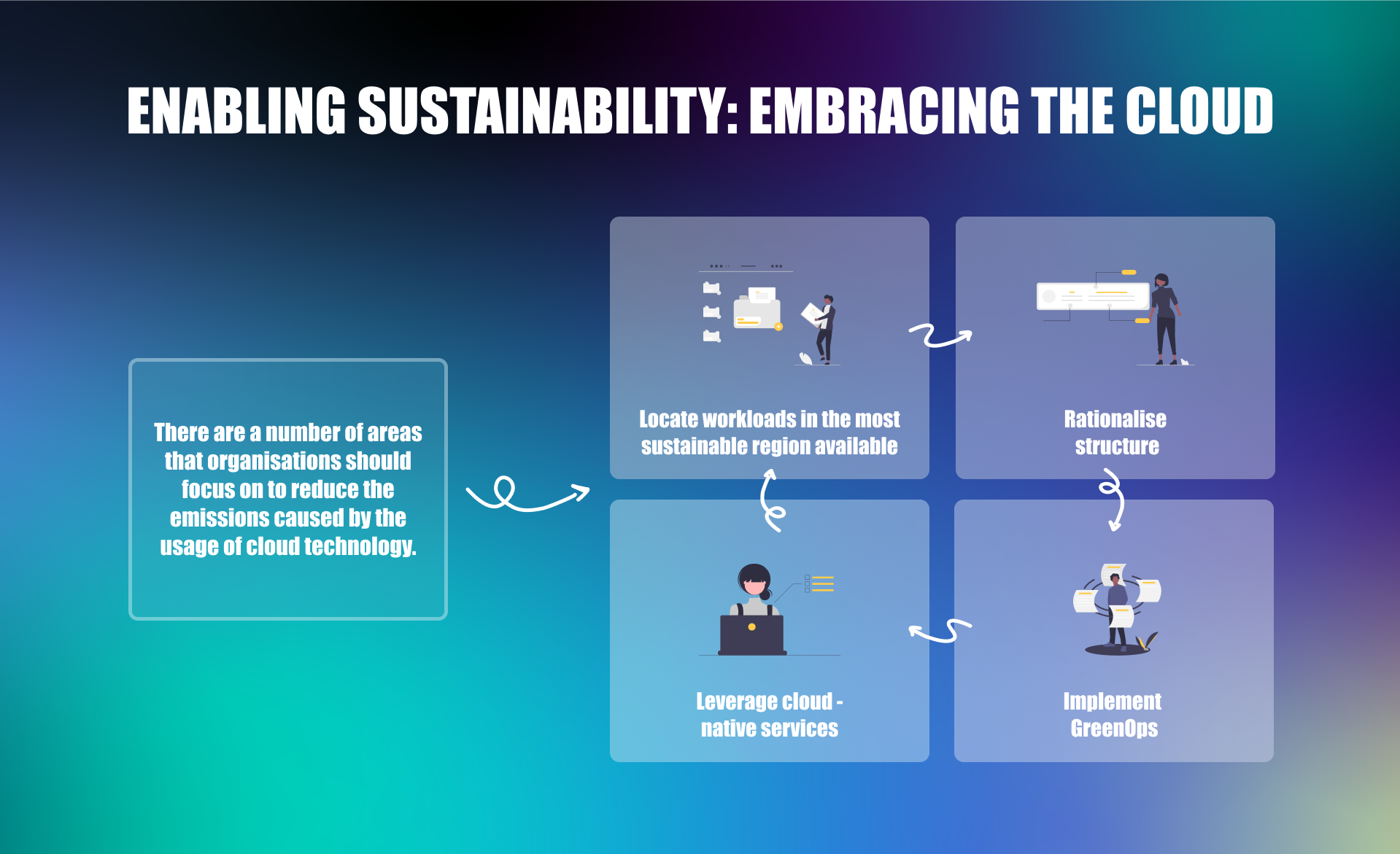Introduction
In today’s rapidly evolving technological landscape, the pursuit of agility, innovation and efficiency has become an imperative. As the world grapples with the challenges of climate change and environmental degradation, harnessing the flexibility of cloud technology can enable organisations to be both more effective and more sustainable. However, it is essential to tread carefully and consider the challenges when using cloud services in order to realise the full benefits.
The Opportunity
Cloud technology offers tremendous potential for sustainability due to its scale and efficient use of resources. By migrating to Infrastructure as a Service (IaaS) and Platform as a Service (PaaS) offerings provided by cloud vendors, organisations can leverage shared infrastructure, reducing the need to run their own physical hardware. The economies of scale of many organisations sharing the same infrastructure reduces not only the total energy required, but also the consumption of rare and heavy metals used during the manufacture of physical hardware. In addition, the huge levels of investment cloud providers are making in creating and operating ever more efficient infrastructure and processes, as well as new and innovative services, is something that few individual organisations could match. The opportunity to reduce costs and increase agility whilst being more sustainable should not be overlooked.
The Challenges
Organisations that simply move existing infrastructure and workloads ‘as-is’ to the cloud – so called “lift and shift migrations” – and do not spend time transforming their operating models and enabling their people to use cloud technology more effectively, rarely recognise promised benefits. In fact, in many cases such an approach can be more expensive for the organisation as well as increase their carbon emissions.
The key challenges that most organisations face when trying to use cloud technology in a sustainable way are:
- Location
The physical location of the cloud data centre an organisation uses makes a big difference to both the cost and the carbon footprint of the data centre – even if using the same provider. Cloud data centres are connected to the national grid, and whilst cloud providers may use Power Purchase Agreements (PPAs) to purchase renewable energy, they still consume energy from the national grid like everyone else. The carbon emitted to generate the energy used to power an organisation’s workloads at the time it needs it, directly contributes to that organisation’s carbon footprint. Using the cloud does not absolve organisations of the emissions – and choosing the wrong location can be a very costly mistake.
- Operations
To fully realise the benefits of the cloud, organisations need to implement operational processes to proactively manage and control emissions – and by association, costs. Compared to traditional on-premises infrastructure, the ease at which resources can be provisioned in the cloud and elastic scale offered by some services means that usage can increase significantly if appropriate controls are not in place. And the more resources that are consumed, the more carbon emitted – and the higher the costs.
- People
Without access to skilled people who can apply sustainable, cloud-native good practices, it is impossible for organisations to efficiently build and run cloud platforms and take advantage of new innovations.
Improving the Sustainability of Cloud Technology
Whether an organisation is already using cloud technology or just starting to, there are a number of areas that organisations should focus on to reduce the emissions caused by the usage of cloud technology:
- Locate workloads in the most sustainable region available
By strategically placing workloads in regions with the highest amount of renewable energy, organisations can minimise their cloud carbon footprint whilst still benefiting from the scalability and flexibility offered by cloud.
- Rationalise infrastructure
By intelligently rationalising and optimising their infrastructure, organisations can significantly reduce costs and emissions simply through more efficient usage of resources.
- Leverage cloud-native services
By embracing consumption-based services that offer elastic scale and do not need to consume resources when not in use, thereby minimising energy consumption, organisations can further reduce their emissions.
- Implement GreenOps
By establishing a GreenOps capability to embrace Lean principles and automation, organisations can drive greater visibility of emissions as well making both efficiency and sustainability improvements to their cloud platforms.
Conclusion
In summary, cloud providers have the greatest scrutiny on their actions, and the biggest economies of scale when taking action on sustainability. They are already driving improvements that will be hard to match in traditional IT infrastructure, and the agility in the cloud allows organisations to respond and optimise faster. Whilst not without its challenges, when used effectively cloud technology can enable organisations to transform their digital workloads to be more sustainable.
Partnering with FSP for a Sustainable Future
If you want to explore other enablers for achieving sustainable digital transformation, we invite you to check out our white paper which also contains pragmatic advice for digital leaders looking to find out more about sustainability and how it can benefit their transformation initiatives. Feel free to get in touch with us at sustainability@fsp.co to find out more about these topics and discuss how we can help your organisation thrive in the realm of sustainability.

